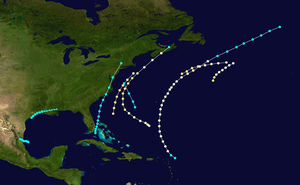| 1863 Atlantic hurricane season | |
|---|---|
 Season summary map | |
| Seasonal boundaries | |
| First system formed | May 24, 1863 |
| Last system dissipated | September 30, 1863 |
| Strongest storm | |
| Name | One, Two, Three, and Four |
| • Maximum winds | 105 mph (165 km/h) (1-minute sustained) |
| Seasonal statistics | |
| Total storms | 9 official, 2 unofficial |
| Hurricanes | 5 official, 1 unofficial |
| Major hurricanes (Cat. 3+) | 0 |
| Total fatalities | 200 |
| Total damage | Unknown |
The 1863 Atlantic hurricane season featured five landfalling tropical cyclones. In the absence of modern satellite and other remote-sensing technologies, only storms that affected populated land areas or encountered ships at sea were recorded, so the actual total could be higher. An undercount bias of zero to six tropical cyclones per year between 1851 and 1885 has been estimated.[1] There were seven recorded hurricanes and no major hurricanes, which are Category 3 or higher on the modern day Saffir–Simpson scale.[2] Of the known 1863 cyclones, seven were first documented in 1995 by José Fernández-Partagás and Henry Diaz,[3] while the ninth tropical storm was first documented in 2003.[4] These changes were largely adopted by the National Oceanic and Atmospheric Administration's Atlantic hurricane reanalysis in their updates to the Atlantic hurricane database (HURDAT), with some adjustments.
Although it is not officially listed in HURDAT, Hurricane "Amanda", named after a ship run aground by the storm, developed in the Gulf of Mexico on May 24. First documented in 2013 by Michael Chenoweth and Cary Mock, the system capsized several other ships and caused damage along the coast of the Florida Panhandle. The cyclone made landfall near Apalachicola, Florida, exceptionally early in the season, on May 28. Amanda is the only known hurricane landfall in the United States in the month of May since HURDAT records began in 1851. On land and at sea, the cyclone left at least 110 fatalities. Few other storms were notable. In August, the third official storm capsized the American brig Bainbridge off Hatteras, North Carolina, drowning 80 people. The seventh official cyclone caused 10 deaths near Tampico, Tamaulipas, after the ship J.K.L. sunk.
- ^ Christopher W. Landsea (2004). "The Atlantic hurricane database re-analysis project: Documentation for the 1851–1910 alterations and additions to the HURDAT database". Hurricanes and Typhoons: Past, Present and Future. New York: Columbia University Press. pp. 177–221. ISBN 0-231-12388-4.
- ^ Atlantic basin Comparison of Original and Revised HURDAT. Hurricane Research Division; Atlantic Oceanographic and Meteorological Laboratory (Report). Miami, Florida: National Oceanic and Atmospheric Administration. 2016. Retrieved January 9, 2017.
- ^ José Fernández-Partagás and Henry F. Diaz (1995a). A Reconstruction of Historical Tropical Cyclone Frequency in the Atlantic from Documentary and other Historical Sources: Year 1870 (PDF). Boulder, Colorado: Climate Diagnostics Center, National Oceanic and Atmospheric Administration. Retrieved 2011-10-14.
- ^ Cite error: The named reference
metawas invoked but never defined (see the help page).
